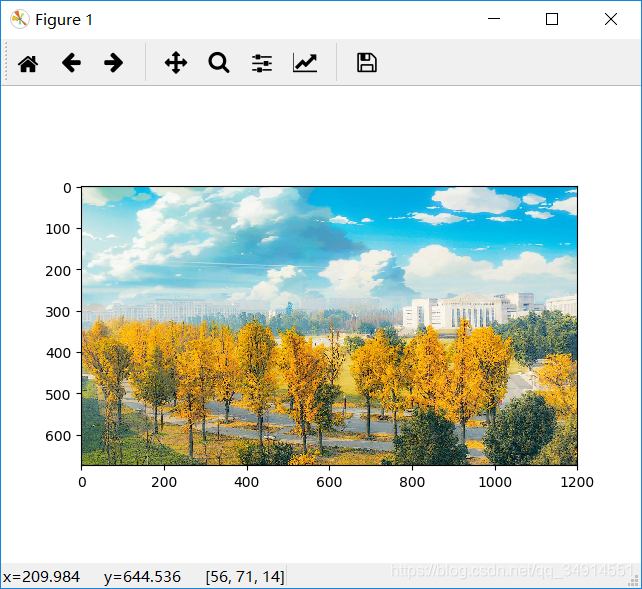附加一个链接关于DatasetAPI:https://zhuanlan.zhihu.com/p/30751039
本文面对三种常常遇到的情况,总结三种读取数据的方式,分别用于处理单张图片、大量图片,和TFRecorder读取方式。并且还补充了功能相近的tf函数。
处理单张图片
我们训练完模型之后,常常要用图片测试,有的时候,我们并不需要对很多图像做测试,可能就是几张甚至一张。这种情况下没有必要用队列机制。
-
import tensorflow
as tf
-
import matplotlib.pyplot
as plt
-
-
def read_image(file_name):
-
img = tf.read_file(filename=file_name)
#默认读取格式为uint8
-
print(
"img 的类型是",type(img));
-
img = tf.image.decode_jpeg(img,channels=
0)
# channels 为1得到的是灰度图,为0则按照图片格式来读
-
return img
-
-
def main( ):
-
with tf.device(
"/cpu:0"):
-
img_path=
'./1.jpg'
-
img=read_image(img_path)
-
with tf.Session()
as sess:
-
image_numpy=sess.run(img)
-
print(image_numpy)
-
print(image_numpy.dtype)
-
print(image_numpy.shape)
-
plt.imshow(image_numpy)
-
plt.show()
-
if __name__==
"__main__":
-
main()
img_path是文件所在地址包括文件名称,地址用相对地址或者绝对地址都行
输出结果为:
-
img 的类型是 <class
'tensorflow.python.framework.ops.Tensor'>
-
[[[
196
219
209]
-
[
196
219
209]
-
[
196
219
209]
-
...
-
-
[[
71
106
42]
-
[
59
89
39]
-
[
34
63
19]
-
...
-
[
21
52
46]
-
[
15
45
43]
-
[
22
50
53]]]
-
uint8
-
(
675,
1200,
3)

和tf.read_file用法相似的函数还有tf.gfile.FastGFile tf.gfile.GFile,只是要指定读取方式是'r' 还是'rb' 。
需要读取大量图像用于训练
这种情况就需要使用Tensorflow队列机制。首先是获得每张图片的路径,把他们都放进一个list里面,然后用string_input_producer创建队列,再用tf.WholeFileReader读取。具体请看下例:
-
def get_image_batch(data_file,batch_size):
-
data_names=[os.path.join(data_file,k)
for k
in os.listdir(data_file)]
-
-
#这个num_epochs函数在整个Graph是local Variable,所以在sess.run全局变量的时候也要加上局部变量。 filenames_queue=tf.train.string_input_producer(data_names,num_epochs=50,shuffle=True,capacity=512)
-
reader=tf.WholeFileReader()
-
_,img_bytes=reader.read(filenames_queue)
-
image=tf.image.decode_png(img_bytes,channels=
1)
#读取的是什么格式,就decode什么格式
-
#解码成单通道的,并且获得的结果的shape是[?, ?,1],也就是Graph不知道图像的大小,需要set_shape
-
image.set_shape([
180,
180,
1])
#set到原本已知图像的大小。或者直接通过tf.image.resize_images
-
image=tf.image.convert_image_dtype(image,tf.float32)
-
#预处理 下面的一句代码可以换成自己想使用的预处理方式
-
#image=tf.divide(image,255.0)
-
return tf.train.batch([image],batch_size)
这里的date_file是指文件夹所在的路径,不包括文件名。第一句是遍历指定目录下的文件名称,存放到一个list中。当然这个做法有很多种方法,比如glob.glob,或者tf.train.match_filename_once
全部代码如下:
-
import tensorflow
as tf
-
import os
-
def read_image(data_file,batch_size):
-
data_names=[os.path.join(data_file,k)
for k
in os.listdir(data_file)]
-
filenames_queue=tf.train.string_input_producer(data_names,num_epochs=
5,shuffle=
True,capacity=
30)
-
reader=tf.WholeFileReader()
-
_,img_bytes=reader.read(filenames_queue)
-
image=tf.image.decode_jpeg(img_bytes,channels=
1)
-
image=tf.image.resize_images(image,(
180,
180))
-
-
image=tf.image.convert_image_dtype(image,tf.float32)
-
return tf.train.batch([image],batch_size)
-
-
def main( ):
-
img_path=
r'F:\dataSet\WIDER\WIDER_train\images\6--Funeral'
#本地的一个数据集目录,有足够的图像
-
img=read_image(img_path,batch_size=
10)
-
image=img[
0]
#取出每个batch的第一个数据
-
print(image)
-
init=[tf.global_variables_initializer(),tf.local_variables_initializer()]
-
with tf.Session()
as sess:
-
sess.run(init)
-
coord = tf.train.Coordinator()
-
threads = tf.train.start_queue_runners(sess=sess,coord=coord)
-
try:
-
while
not coord.should_stop():
-
print(image.shape)
-
except tf.errors.OutOfRangeError:
-
print(
'read done')
-
finally:
-
coord.request_stop()
-
coord.join(threads)
-
-
-
if __name__==
"__main__":
-
main()
这段代码可以说写的很是规整了。注意到init里面有对local变量的初始化,并且因为用到了队列,当然要告诉电脑什么时候队列开始, tf.train.Coordinator 和 tf.train.start_queue_runners 就是两个管理队列的类,用法如程序所示。
输出如下:
与 tf.train.string_input_producer相似的函数是 tf.train.slice_input_producer。 tf.train.slice_input_producer和tf.train.string_input_producer的第一个参数形式不一样。等有时间再做一个二者比较的博客
对TFRecorder解码获得图像数据
其实这块和上一种方式差不多的,更重要的是怎么生成TFRecorder文件,这一部分我会补充到另一篇博客上。
仍然使用 tf.train.string_input_producer。
-
import tensorflow
as tf
-
import matplotlib.pyplot
as plt
-
import os
-
import cv2
-
import numpy
as np
-
import glob
-
-
def read_image(data_file,batch_size):
-
files_path=glob.glob(data_file)
-
queue=tf.train.string_input_producer(files_path,num_epochs=
None)
-
reader = tf.TFRecordReader()
-
print(queue)
-
_, serialized_example = reader.read(queue)
-
features = tf.parse_single_example(
-
serialized_example,
-
features={
-
'image_raw': tf.FixedLenFeature([], tf.string),
-
'label_raw': tf.FixedLenFeature([], tf.string),
-
})
-
image = tf.decode_raw(features[
'image_raw'], tf.uint8)
-
image = tf.cast(image, tf.float32)
-
image.set_shape((
12*
12*
3))
-
label = tf.decode_raw(features[
'label_raw'], tf.float32)
-
label.set_shape((
2))
-
# 预处理部分省略,大家可以自己根据需要添加
-
return tf.train.batch([image,label],batch_size=batch_size,num_threads=
4,capacity=
5*batch_size)
-
-
def main( ):
-
img_path=
r'F:\python\MTCNN_by_myself\prepare_data\pnet*.tfrecords'
#本地的几个tf文件
-
img,label=read_image(img_path,batch_size=
10)
-
image=img[
0]
-
init=[tf.global_variables_initializer(),tf.local_variables_initializer()]
-
with tf.Session()
as sess:
-
sess.run(init)
-
coord = tf.train.Coordinator()
-
threads = tf.train.start_queue_runners(sess=sess,coord=coord)
-
try:
-
while
not coord.should_stop():
-
print(image.shape)
-
except tf.errors.OutOfRangeError:
-
print(
'read done')
-
finally:
-
coord.request_stop()
-
coord.join(threads)
-
-
-
if __name__==
"__main__":
-
main()
在read_image函数中,先使用glob函数获得了存放tfrecord文件的列表,然后根据TFRecord文件是如何存的就如何parse,再set_shape
这里有必要提醒下parse的方式。我们看到这里用的是tf.decode_raw ,因为做TFRecord是将图像数据string化了,数据是串行的,丢失了空间结果。从features中取出image和label的数据,这时就要用 tf.decode_raw 解码,得到的结果当然也是串行的了,所以set_shape 成一个串行的,再reshape。这种方式是取决于你的编码TFRecord方式的。
再举一种例子:
-
reader=tf.TFRecordReader()
-
_,serialized_example=reader.read(file_name_queue)
-
features = tf.parse_single_example(serialized_example, features={
-
'data': tf.FixedLenFeature([
256,
256], tf.
float32),
-
'label': tf.FixedLenFeature([], tf.
int64),
-
'id': tf.FixedLenFeature([], tf.
int64)
-
})
-
img = features[
'data']
-
label =features[
'label']
-
id = features[
'id']
这个时候就不需要任何解码了。因为做TFRecord的方式就是直接把图像数据append进去了。